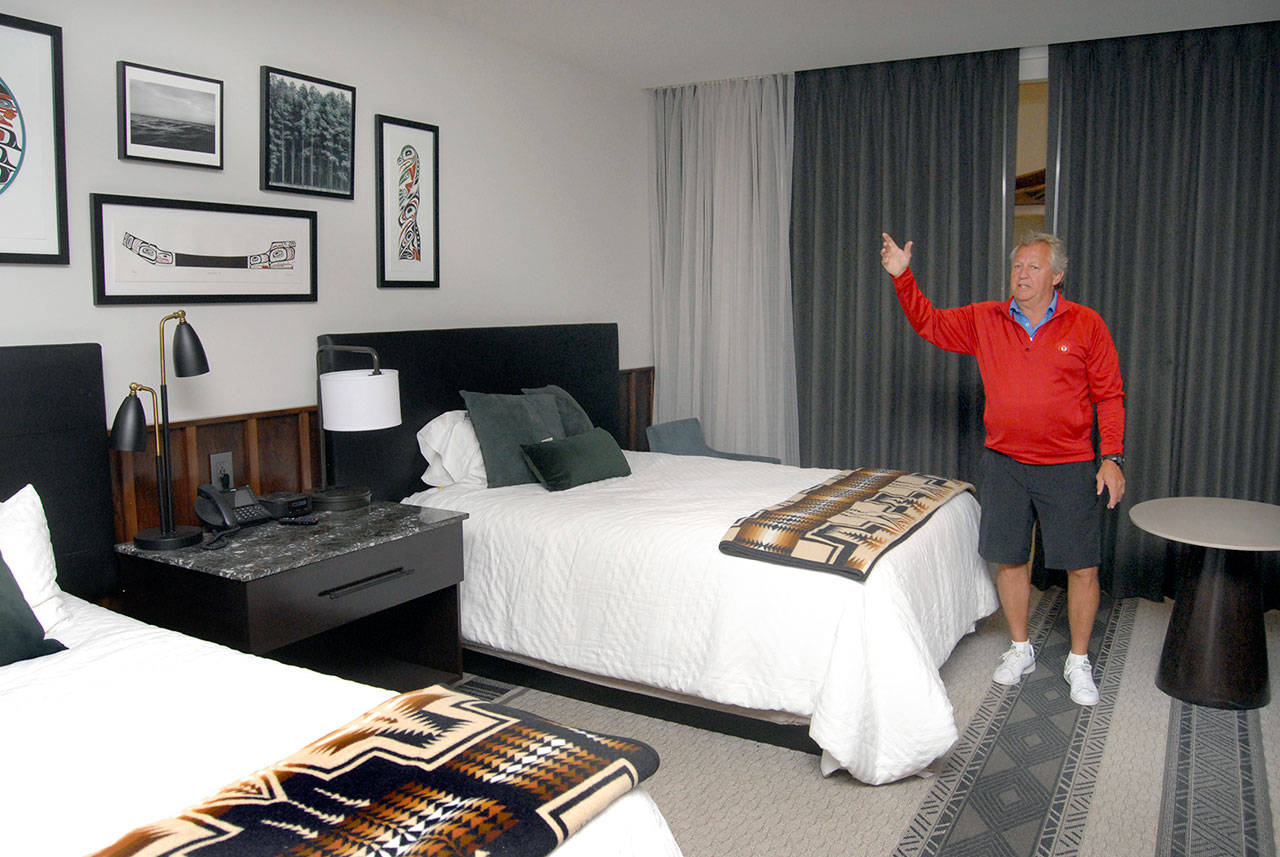Twelve months from now, the Jamestown S’Klallam Tribe expects to open its 100-room, $39 million hotel at 7 Cedars Casino.
“We plan on opening the doors in May of next year,” tribal casino and hotel CEO Jerry Allen said on May 9.
“We are pouring concrete, and we are off and running.”
Allen, assisted by hotel manager Debbie Wardrop, the former general manager of The Resort at Port Ludlow, gave a 45-minute presentation to the Kiwanis Club of Port Angeles luncheon meeting last week.
Allen said the four-star hotel, which will be connected to the casino, is Phase 1 of a five-phase, 20-year development strategy at the U.S. Highway 101 site at Blyn, 6.5 miles east of Sequim.
Wardrop said the five-story, 80-foot-tall facility will employ 70-80 people.
Allen said work on a hotel connection with the city of Sequim’s sewer system will begin this week.
The flow of traffic also will soon change at the casino as part of Phase 1, Allen said.
A road from the Longhouse Market & Deli to the hotel site will be completed by the end of this month.
A loop trail also will be built from the Longhouse to the hotel, Allen added.
He said in an interview that rooms will be sold to customers beginning this July at more than $275 each, exceeding the highest room rates on the North Olympic Peninsula.
The marketing plan focuses on “higher end” travellers including golfers from the Puget Sound region drawn from the tribe’s player data base, he said.
Many will have played at the tribe’s Cedars at Dungeness golf course, overseen by Allen, and at Peninsula Golf Club in Port Angeles, where the pro shop is managed by the tribe.
The hotel will include two conference spaces totalling 220 seats, a coffee shop “marketplace” selling sundries — not including cigarettes — and a smoking “curtain” dividing the casino, where smoking will be allowed, from the hotel, where it will not be allowed, Wardrop and Allen told club members.
Once the hotel is built the casino, now open from 9 a.m.-2 a.m. every day, will be open 24 hours a day, as will Napoli’s restaurant in the casino, which will provide room service.
Allen said the hotel is being built west of the casino, taking up existing parking.
A 5-acre parking lot with 450 stalls including 32 RV hookups will be added to the east of the casino, he said.
As part of Phase 2 of the project, a parking garage is planned for behind the hotel to be less visible from the highway.
“We’re still negotiating with the landowner back there,” Allen said. “It’s been in his family for generations. He knows where we want to go with it.”
Allen expects at least 30 percent of hotel guests will be drawn from the tribe’s casino and golfer data base, with many golfers expected to play at both courses.
Hotel guests can check in and check out via mobile aps, Allen said.
“The customer experience is going to be very different,” he said.
Standard rooms will be 430 square feet, with some 700 square feet.
Allen said the room hallways will be uniquely designed with tiny alcoves at each doorway.
He assured one questioner at the meeting that security will be adequate, pointing to the 300 surveillance cameras at the casino.
“It’s amazing that some of your employees forget about that, but it’s so true,” Allen quipped.
The hotel will include art in various mediums from both Native American and non-Native American artists whose works will be displayed along a 70-foot lobby hallway.
“You might see someone doing jewelry, or painting or talking about what it takes to create,” Wardrop said.
“We will find ways to carry on that tradition.
“We might have local music going on all the time.”
Allen said it will include an 18-20-foot tall paneled wall with carvings and an eighth totem pole outside as an addition to the seven at the casino, which will be repainted to match the color of the hotel.
Asked about provisions being made for a Cascasdia Subduction Zone earthquake, Allen said the hotel, like the casino, will be built on top of 60-80-foot pilings.
“We have holes now that fill up with 9 feet of water when the tide comes in,” Allen said.
In an interview, Allen said the long-range strategy includes a Phase 2 plan for adding 150-200 more rooms with “tremendously more conference space” than the hotel, which will have two meeting spaces totaling 220 seats.
“The conference space helps build the rooms,” he said.
“A hotel can take a casino and fundamentally build its bottom line by 20 to 30 percent.”
Phase 2 will be considered after three years of hotel operations, Allen said in an interview after his presentation.
“We’ll see how the numbers match up, how the bank likes the repayment schedule, and did it meet our feasibility study goal of increasing our bottom line by 30 percent, and we’ll follow that,” Allen said.
“The second phase will definitely be a lot more than $39 million.”
Other phases could include adding a swimming pool, a spa and “executive cabins,” Allen said.
As the phases develop, the facility “will become more of a destination,” he said. “This first phase is definitely more gaming-centric.”



